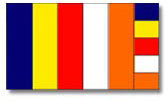|

The Buddhist Flag
The Buddhist flag,
first hoisted in 1885 in Sri Lanka, is a symbol of faith
and peace used throughout the world to represent the Buddhist
faith.
The six colours; Blue (nila), Yellow (pita), Red (lohita), White
(odata),
Scarlet (manjestha), and the mixture of these six colours (prabaswara)
of
the flag represent the colours of the aura that emanated from
the body of
the Buddha when He attained Enlightenment under the Bodhi Tree.
The Horizontal Stripes represent the races of the world living
in harmony
and the Vertical Stripes represent eternal world peace. The colours
symbolize the perfection of Buddhahood and the Dharma.
The Blue light that radiated from the Buddha's hair symbolizes
the spirit of
Universal Compassion for all beings.
The Yellow light that radiated from the Buddha's epidermis symbolizes
the
Middle Way which avoids all extremes and brings balance and liberation.
The Red light that radiated from the Buddha's flesh symbolizes
the blessings
that the practice of the Buddha's Teaching brings.
The White light that radiated from the Buddha's bones and teeth
symbolizes
the purity of the Buddha's Teaching and the liberation it brings.
The Orange light that radiated from the Buddha's palms, heels
and lips
symbolizes the unshakable Wisdom of the Buddha's Teaching.
The Combination Colour
symbolizes the universality of the Truth of the Buddha's Teaching.
(Burmese Buddhist replaced with Pink.)
Therefore, the overall flag represents that:
Regardless of race, nationality, division or colour, all sentient
beings
possess the potential of Buddhahood.
The six colours are better interpreted as :
1. Blue: signifying the concept of loving kindness and peace in
Buddhism
2. Yellow: signifying the Middle Path, that is, the complete absence
of form
and emptiness
3. Red: signifying achievement, wisdom, virtue, fortune and dignity.
4. White: signifying
purity, emancipation, that the Dharma will always exist
regardless of time or space.
5. Orange: The essence of Buddhism which is full of wisdom, strength
and
dignity.
6. The combination of these five colours symbolizes the one Truth.
The horizontal bars signify peace and harmony between all races
through out
the world while the vertical bars represent eternal peace within
the world.
In simple terms, the Buddhist Flag implies that there is no discrimination
of races, nationality, areas or skin colour; that every living
being possess
the Buddha Nature and all have the potential to become a Buddha.
------------------------------------------------------------------------
Many people, including
Buddhists, believe that their flag dates back to the
time of Dutugamunu (second-century BC). In fact, the flag was
invented in
1880 by an American journalist, Colonel Henry Steele Olcott. Olcott
was a
fascinating character. A former soldier and lawyer, he set up
the
Theosophical Society of New York. He
arrived in Sri Lanka with the renowned
spiritualist Madame Blavatsky on 17 February 1880- a day which
was
subsequently celebrated as Olcott Day in independent Sri Lanka.
He founded
the Buddhist Theosophical Society, devised a Buddhist catechism,
encouraged
Buddhist versions of Christmas carols and cards, and inspired
the founding
of Buddhist schools and the YMBA - the Young Men's Buddhist Association.
There are six
colours in the flag, but the human eyes can see only five.
They are described in the Scriptures as emanating from the aura
around the
Buddha's head. There are 5 vertical stripes of red, yellow, blue,
white and
orange. The sixth colour is a compound of the first 5, but for
design
purposes its five ingredients are all shown in small horizontal
stripes on
the fly.
However, Olcott
felt that local Buddhists in Sri Lanka needed a symbol to
rally around. His flag achieved that: it became the emblem of
the
international Buddhist movement and is flown today worldwide in
Buddhist
buildings and at Buddhist celebrations. When he died in 1907,
Olcott's body
was shrouded in both the Buddhist and American flags before his
cremation.
|